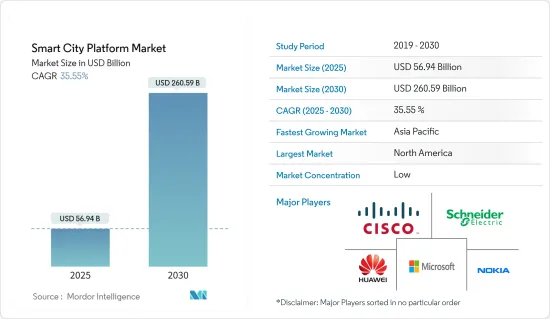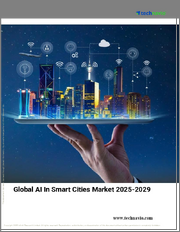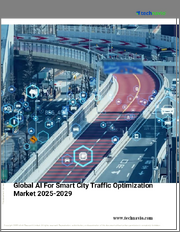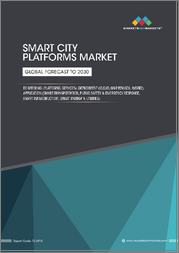
|
시장보고서
상품코드
1687886
스마트 시티 플랫폼 시장 : 시장 점유율 분석, 산업 동향 및 통계, 성장 예측(2025-2030년)Smart City Platform - Market Share Analysis, Industry Trends & Statistics, Growth Forecasts (2025 - 2030) |
||||||
스마트 시티 플랫폼 시장 규모는 2025년에 569억 4,000만 달러로 추정되고, 2030년에는 2,605억 9,000만 달러에 이를 것으로 예측되며, 시장 예측 기간인 2025-2030년 CAGR 35.55%로 성장할 전망입니다.

COVID-19의 대유행은 공중보건과 안전에 대한 우려를 줄이는 연결 인프라와 솔루션에 대한 투자의 필요성이 높아졌습니다. 안전하고 안정적인 운송 및 커넥티드 용도에 대한 수요는 혼잡, 접근 문제, 지연에 대한 실시간 경고를 제공함으로써 시스템을 더 안전하게 만들고 사람들이 더 나은 정보에 기반한 공공 운송 이용을 결정할 수 있도록 하기 위해 높아졌습니다.
주요 하이라이트
- 스마트 시티는 도시화로 세계적으로 확대되고 있으며, 이것이 시장의 성장을 가능하게 하고 있습니다. 유엔의 예측에 따르면 2050년까지 인도에서 4억 400만 명, 중국에서 2억 9,200만 명, 나이지리아에서 2억 1,200만 명의 도시 거주자가 기존 인구에 추가될 것으로 예상됩니다.
- 정부의 이니셔티브와 지출도 확장성과 다른 스마트 솔루션과의 통합성을 통해 단독 스마트 솔루션보다 플랫폼 제공업체의 중요성을 높여 왔습니다. 예를 들어 2022년 1월 현재 인도 정부는 100개의 스마트 시티에 2,841억 3,600만 루피를 출연하고 있습니다.
- 스마트 시티 플랫폼은 분석, 원격 자산 모니터링, 성능 관리, 의사 결정 지원, 프레젠테이션 구성 요소 등 다양한 기능을 수행합니다. 기술적으로 선진적인 도시의 대부분은 사물인터넷(Internet of Things) 플랫폼을 사용하여 도시의 인프라를 모니터링하고, 교통 흐름과 주차장에서 수질과 대기질까지 관리하고, 얻은 스마트 데이터를 사용하여 환경 지속가능성에 대한 장기적인 계획 결정을 추진하고 있습니다.
- 스마트 시티 플랫폼은 도시 인프라, 용도, 서비스 및 도시별 다양한 기능의 기반을 설명합니다. 도시 시장 성장을 가속할 것으로 예상되는 중요한 요소 중 하나는 확장성과 다른 스마트 솔루션 간의 통합성을 통해 단일 스마트 솔루션에 비해 플랫폼 제공업체를 선호하는 것입니다.
- 세계의 스마트 시티 프로젝트가 성장하고 그 속도를 높이면서 주요 비전, 기술, 현장 수준의 현실은 계층화되고 대처가 복잡해지고 있습니다. 또한 이러한 복잡성을 간소화하기 위해 방대한 양의 생성 데이터를 수집 및 분석하기 위한 머신러닝 솔루션의 채용 확대 등 보다 직관적인 프로세스 이용을 위해 시장이 강력하게 추진될 것으로 예상됩니다.
스마트 시티 플랫폼 시장 동향
스마트 정부가 주요 용도 부문으로
- 스마트 시티 플랫폼은 정부 프로그램의 효율성을 높이고 수혜자에게 도달하도록 지원합니다. 일부 스마트 시티는 공공 부문의 효율성을 높이고 지속 가능한 개발을 지원하기 위해 정부 시스템을 간소화하는 전자 정부 이니셔티브를 통해 시민 참여에 기술을 활용할 전망입니다.
- 전자정부는 시민들이 빠르고 쉽게 주요 행정서비스에 액세스할 수 있도록 온라인 원스텝의 게이트웨이를 이용합니다. 예를 들어 지방자치단체가 출생, 결혼, 사망과 같은 라이프 이벤트 기록을 종이 파일이 아닌 클라우드에 보관해 정부 직원과 직원이 쉽게 접근할 수 있도록 하는 것을 들 수 있습니다.
- Huawei의 전자 정부는 정부의 네트워크, 클라우드, 공동 사무소, 다각적인 보안, 업무 효율화를 위한 필수 플랫폼입니다. 인도에서 Cisco는 Wi-Fi, 원격 전자정부, 시민 키오스크 등의 솔루션을 도입하고 Cisco Kinetic for Cities 및 분석 솔루션과 결합하여 City Command and Control Centre(C-4)에 도입하고 있습니다.
- Huawei 기술은 Horizon Digital Platform을 기반으로 데이터와 다양한 ICT 기술의 통합을 최적화하고 서비스 프로세스를 간소화하고 정보 흐름을 전달하는 지능형 시티 솔루션인 HiCity를 발표했습니다. 에코시스템 파트너와 함께, 이 회사는 스마트 시티의 거버넌스 및 혁신을 보다 잘 지원하는 것을 목표로 하고 있습니다.
- 커뮤니티 활성화와 안전성 향상 등 현대 도심부가 직면하는 문제 해결을 지원하기 위해 이 서비스는 IoT 기술을 이용하여 지역 및 도시 전체의 여러 장소에서 많은 부문와 영역(예 : 재해 관리, 관광, 에너지 등)의 종합적인 데이터를 수집합니다.
- European Telecommunications Network Operations(ETNO)에 따르면 IoT 스마트 빌딩의 활성 연결 수는 매년 증가할 것으로 예상됩니다. 2019년 접속 수는 1,599만 건으로 2025년에는 1억 5,406만 건에 이를 것으로 예상됩니다.
북미가 시장을 독점할 전망
- 북미는 스마트 시티 솔루션의 광범위한 채용, 정부 조직의 높은 ICT 투자, 지역 전체의 연계 솔루션에 대한 높은 수요에 의해 수익 면에서 스마트 시티 지역 시장의 지배적인 지위를 확립했습니다.
- 이 지역은 스마트 시티 플랫폼 개발의 주도적인 지역 중 하나입니다. IoT 스마트 시티 기술은 도시가 보다 효율적으로 자원을 이용해 대기와 수질부터 교통, 에너지, 통신 시스템까지 모든 것을 개선하는 데 필요한 최첨단 인텔리전스와 유연성을 가능하게 합니다. 스마트 아메리카에 따르면 미국 도시 정부는 향후 20년간 약 41조 달러를 투자하고 IoT의 이점을 활용하기 위해 인프라를 업그레이드할 가능성이 있습니다.
- 게다가 이 지역에는 강력한 골격을 가진 벤더가 존재하고, 시장의 성장에 공헌하고 있습니다. 벤더로는 Microsoft Corporation, Cisco Systems Inc., GE Current, IBM Corporation 등이 있습니다.
- 인터넷 보급률 증가도 스마트 시티 플랫폼의 기반으로서 기능하는 IoT 접속을 가능하게 하고, 스마트 시티 플랫폼의 확립에 중요한 역할을 하고 있습니다. 국내 통신사업자 KT의 혁신적 기술 '기가와이어'의 첫 회선이 미국에 설치됐습니다. 광섬유 케이블 없이 최대 1Gbps의 인터넷 속도를 기재하고 있습니다. 이 노력은 네트워크 인프라 개선을 목적으로 한 보스턴 디지털 에쿼티 프로젝트에 따른 것입니다.
- 2021년에는 라스베가스와 뉴욕이 디지털 트윈 기술을 채용해, 피닉스나 다른 미국이나 유럽의 도시도 이에 이어질 것으로 예상되고 있습니다. 그러나 도시 디지털 트윈 플랫폼의 선도 기업인 미국 Cityzenith는 2021년 말까지 10개 도시, 2024년까지 100개 도시에 이 기술을 기증할 계획입니다.
- 2021년 3월, Nokia는 대체 에너지 시스템 프로바이더의 클리어 월드사와 재판매 계약을 맺어, Nokia의 스마트 시티 솔루션 포트폴리오의 일환으로서, 미국의 도시나 군사 기지에 스마트 폴을 판매합니다. 클리어월드사의 커넥티드 디지털 폴은 비디오 분석, Wi-Fi 액세스 포인트, 총성 감지, 스마트 조명, 번호판 판독 등의 용도를 지원하고 있습니다.
- 또한 도시화로 인해 교통량이 증가하고 기후 변화가 진행되고 있기 때문에 차세대 교통 모니터링 및 관리 솔루션이 시급해지고 있습니다. 도시의 교통 모니터링 카메라 도입은 클라우드 접근과 광대역 인터넷 인프라를 필요로 하는 자율형 비디오 모니터링 시스템의 부족과 열악한 시스템으로 인해 방해받고 있습니다.
스마트 시티 플랫폼 산업 개요
스마트 시티 플랫폼시장은 경쟁이 치열하고, 세계 많은 기업들이 이러한 플랫폼을 제공하고 있습니다. 각 시장 참가 기업은, 제공하는 솔루션을 항상 진화 및 혁신시켜, 세계의 시장 점유율의 대부분을 획득하고 있습니다. 각 회사는 연구개발에 거액의 자금을 투입해 다양한 기술을 통합해 새로운 솔루션을 혁신하고 있어 시장 경쟁이 치열합니다.
- 2021년 11월-마닐라시 정부는 Microsoft와 파트너십을 맺고 21세기형 경제 구축이라는 Microsoft의 목표를 가속화하고 시정부 내부의 업무 방식을 강화합니다. 또한 이 파트너십은 시 전체의 디지털 데이터 인프라 구상인 동시의 'Go Manila' 플랫폼 최적화와 데이터 거버넌스 방침 강화를 목적으로 하고 있습니다. Microsoft는 정부 고유의 리소스와 인공지능 전문 지식에 대한 접근을 제공하여 미래 디지털 계획의 시야를 넓힙니다.
- 2021년 10월-Cyta는 니코시아시에서 통합 운영 센터(IOC) 솔루션을 제공하기 위해 Nokia를 선택하여 니코시아시는 스마트 시티화를 진행하고 시민 서비스를 강화하며 환경의 지속가능성을 향상시킬 수 있습니다. 또한, Nokia의 IOC는 도시 이동성, 스마트 주차, 지능형 가로등, 환경 센서, 지속 가능한 폐기물 관리, 디지털 간판, 정보 서비스 등 다양한 새로운 디지털 서비스를 설명합니다.
- 2021년 3월-노키아는 니코시아의 장기적인 스마트 시티 전략의 일환으로 니코시아에 스마트 시티 관리 플랫폼을 제공한다고 발표했습니다. 이 플랫폼은 기존 시민 서비스를 강화하고 모빌리티, 스마트 파킹, 지능형 조명, 지속가능한 폐기물 관리 등 부문에서 시 당국이 다양한 새로운 서비스를 제공할 수 있도록 합니다.
기타 혜택
- 엑셀 형식 시장 예측(ME) 시트
- 3개월간의 애널리스트 서포트
목차
제1장 서론
- 조사의 전제조건 및 시장 정의
- 조사 범위
제2장 조사 방법
제3장 주요 요약
제4장 시장 역학
- 시장 개요
- 시장 성장 촉진요인
- 인터넷과 IoT 디바이스의 보급 확대
- 정부에 의한 스마트 시티에 대한 주목 고조
- 시장 성장 억제요인
- 정부에 의한 스마트 시티에 대한 주력 고조
- 밸류체인 및 공급망 분석
- 산업의 매력-Porter's Five Forces 분석
- 공급기업의 협상력
- 소비자의 협상력
- 신규 참가업체의 위협
- 대체품의 위협
- 경쟁 기업간 경쟁 관계
제5장 시장 세분화
- 플랫폼 유형별
- 연결성 관리 플랫폼
- 통합 플랫폼
- 디바이스 관리 플랫폼
- 데이터 관리 플랫폼
- 보안 관리 플랫폼
- 용도별
- 스마트 모빌리티 및 트랜스포테이시녀
- 스마트 보안
- 스마트 유틸리티
- 스마트 정부
- 스마트 인프라
- 스마트 의료
- 기타
- 전개별
- 온프레미스
- 클라우드
- 지역별
- 북미
- 유럽
- 아시아태평양
- 라틴아메리카
- 중동 및 아프리카
제6장 경쟁 구도
- 기업 프로파일
- Siemens AG
- Schneider Electric SE
- Microsoft Corporation
- Hitachi Ltd
- Huawei Technologies
- Cisco Systems Inc.
- Current, Powered by GE
- IBM Corporation
- Alibaba Group Holding Limited
제7장 시장 기회 및 향후 동향
AJY 25.05.07The Smart City Platform Market size is estimated at USD 56.94 billion in 2025, and is expected to reach USD 260.59 billion by 2030, at a CAGR of 35.55% during the forecast period (2025-2030).

The COVID-19 pandemic heightened the need to invest in connectivity infrastructure and solutions that alleviate public health and safety concerns. The demand for safe and secure transport and connected applications rose to make systems safer by providing real-time warnings about crowding, access problems, or delays to help people make better informed public travel decisions.
Key Highlights
- Smart cities are growing globally due to urbanization, which is enabling market growth. According to projections by the United Nations, in India, 404 million, China, 292 million, and Nigeria, 212 million urban dwellers are expected to be added to the existing populations by 2050.
- The government initiatives and spending are also giving much more significance to platform providers than standalone smart solutions because of the scalability and integration of other smart solutions. For instance, as of January 2022, the Indian government has released INR 28,413.6 crore for 100 smart cities.
- Smart city platforms perform various functions, such as analytics, remote asset monitoring, performance management, decision support, or presentation components. Most technologically advanced cities use the Internet of Things platform to monitor city infrastructure, manage traffic flows and parking to water and air quality, and use the resulting smart data to tackle longer-term planning decisions around environmental sustainability.
- The smart city platforms offer a foundation for urban infrastructure, applications, services, and various city-specific functions. One of the significant factors expected to drive the market's growth in cities is giving priority to platform providers compared to standalone smart solutions because of the scalability and integration of other smart solutions.
- As smart city projects across the world have grown and have taken up the pace, the primary vision, the technologies, and the realities on the ground level have become layered and more complex to deal with. Furthermore, to simplify these complexities, the market will witness a strong drive toward the usage of more intuitive processes, which includes the increased adoption of machine learning solutions to gather and analyze the huge amount of generated data.
Smart City Platforms Market Trends
Smart Governance to be the Major Application Area
- The smart city platform increases the efficiency of government programs and helps them reach their beneficiaries. Some smart cities are trying to put technology to use to engage their citizens through eGovernment initiatives, which improve public sector efficiency and streamline government systems to support sustainable development.
- eGovernment uses online, one-step gateways for citizens to access primary government services quickly and easily. An example would be a local government keeping records of life events - births, marriages, deaths - in the cloud, rather than in paper files, for easy access for government officials and employees.
- Huawei e-Government is an integral platform for government networks, cloud, collaborative offices, multi-dimensional security, and operational efficiency. In India, Cisco has implemented solutions such as Wi-Fi, remote e-governance, and citizen kiosks, coupled with Cisco Kinetic for Cities and analytics solutions at City Command and Control Centre (C-4).
- Based on the Horizon Digital Platform, Huawei Technologies Co. Ltd announced the launch of the "HiCity" Intelligent City Solution that optimizes the integration of the data and a variety of ICT technologies to streamline service processes and transfer information flows, reducing the threshold for the use of new technologies and making integration easier. Together with ecosystem partners, the company aims better to support the governance and innovation of smart cities.
- To help solve some of the issues faced in modern urban centers, such as the revitalization of communities and enhancement of safety, this service uses IoT technology to collect comprehensive data in numerous fields and spheres (for example, disaster management, tourism, energy, etc.) from multiple locations throughout the region and city.
- As per European Telecommunications Network Operations (ETNO), the number of IoT smart buildings' active connections was expected to increase through the years. It was 15.99 million connections in 2019 and is expected to reach 154.06 million by 2025.
North America Expected to Dominate the Market
- North America emerged as the dominant regional market for smart cities in terms of revenue, owing to widespread adoption of smart city solutions, high ICT investment among government organizations, and high demand for linked solutions across the region.
- It is one of the leading regions in terms of the development of smart city platforms. IoT Smart Cities' technology enables the cutting-edge intelligence and flexibility necessary to help cities use resources more efficiently and improve everything, from air and water quality to transportation, energy, and communication systems. According to Smart America, the governments in the cities of the United States may invest approximately USD 41 trillion over the next 20 years to upgrade their infrastructure to leverage the benefits of the IoT.
- Furthermore, the region has a strong foothold of vendors, contributing to the market studied's growth. Some vendors include Microsoft Corporation, Cisco Systems Inc., GE Current, and IBM Corporation.
- Increasing internet penetration also plays a crucial role in establishing smart city platforms, enabling IoT connections that act as a base for smart city platforms. The first line of South Korean telecom provider KT's innovative technology, 'GiGa Wire, was installed in the United States. It provides an internet speed of up to 1 Gbps without any fiber-optic cable. This initiative is in line with the Boston Digital Equity Project, which is aimed to improve network infrastructure.
- In 2021, Las Vegas and New York City adopted the Digital Twin technology, with Phoenix and other U.S. and European cities expected to follow. However, Cityzenith, United States, the leading Urban Digital Twin platform, plans to donate the technology to 10 cities by the end of 2021 and 100 cities by 2024.
- In March 2021, Nokia signed a reseller agreement with ClearWorld, an alternative energy systems provider, to sell smart poles to U.S. cities and military bases as part of Nokia's smart city solutions portfolio. It will be deployed in parks, parking lots, and roadways; the ClearWorld connected digital pole supports applications such as video analytics, Wi-Fi access points, gunshot detection, smart lighting, and license plate reading.
- Furthermore, urbanization results in increased traffic and climate change which drives the urgent need for a next-generation traffic monitoring and management solution. The deployment of traffic cameras in cities is hampered by a lack of or subpar autonomous video monitoring systems that require cloud access or extensive high-bandwidth internet infrastructure.
Smart City Platforms Industry Overview
The Smart City Platform Market is highly competitive, with many companies providing such platforms across the globe. The market players are consistently evolving and innovating the solutions they provide to attract most of the market share globally. Companies are spending huge sums of money on R&D to innovate new solutions by integrating different technologies, making it a highly competitive market.
- November 2021 - The Manila Municipal Government formed a partnership with Microsoft to accelerate Microsoft's goal of building a 21st-century economy and strengthening how the city government works internally. Also, the partnership aims to optimize the city's "GoManila" platform, a city-wide digital data infrastructure initiative, and strengthen its data governance policy. Microsoft will provide access to government-specific resources and expertise in artificial intelligence, broadening the horizons of future digital plans.
- October 2021 - Cyta chose Nokia to deliver its Integrated Operations Center (IOC) solution in the Municipality of Nicosia. This enables Nicosia to advance its smart city transformation, enhancing citizen services and improving environmental sustainability. Nokia IOC will also deliver a range of new digital services, including urban mobility, smart parking, intelligent street lighting, environmental sensors, sustainable waste management, digital signage, and information services.
- March 2021 - Nokia has announced to deliver a smart city management platform for Nicosia as a part of Nicosia's long-term smart city strategy. The platform will enhance existing citizen services and enable city authorities to deliver a range of new ones in areas such as mobility, smart parking, intelligent lighting, and sustainable waste management.
Additional Benefits:
- The market estimate (ME) sheet in Excel format
- 3 months of analyst support
TABLE OF CONTENTS
1 INTRODUCTION
- 1.1 Study Assumptions and Market Definition
- 1.2 Scope of the Study
2 RESEARCH METHODOLOGY
3 EXECUTIVE SUMMARY
4 MARKET DYNAMICS
- 4.1 Market Overview
- 4.2 Market Drivers
- 4.2.1 Rising Adoption of Internet and IoT Devices
- 4.2.2 Governments Increasing Focus on Smart City
- 4.3 Market Restraints
- 4.3.1 Governments Increasing Focus on Smart City
- 4.4 Value Chain / Supply Chain Analysis
- 4.5 Industry Attractiveness - Porter's Five Forces Analysis
- 4.5.1 Bargaining Power of Suppliers
- 4.5.2 Bargaining Power of Consumers
- 4.5.3 Threat of New Entrants
- 4.5.4 Threat of Substitutes
- 4.5.5 Intensity of Competitive Rivalry
5 MARKET SEGMENTATION
- 5.1 Platform Type
- 5.1.1 Connectivity Management Platform
- 5.1.2 Integration Platform
- 5.1.3 Device Management Platform
- 5.1.4 Data Management Platform
- 5.1.5 Security Management Platform
- 5.2 Application
- 5.2.1 Smart Mobility/Transportation
- 5.2.2 Smart Security
- 5.2.3 Smart Utilities
- 5.2.4 Smart Governance
- 5.2.5 Smart Infrastructure
- 5.2.6 Smart Healthcare
- 5.2.7 Other Applications
- 5.3 Deployment
- 5.3.1 On-premise
- 5.3.2 Cloud
- 5.4 Geography
- 5.4.1 North America
- 5.4.2 Europe
- 5.4.3 Asia Pacific
- 5.4.4 Latin America
- 5.4.5 Middle East and Africa
6 COMPETITIVE LANDSCAPE
- 6.1 Company Profiles
- 6.1.1 Siemens AG
- 6.1.2 Schneider Electric SE
- 6.1.3 Microsoft Corporation
- 6.1.4 Hitachi Ltd
- 6.1.5 Huawei Technologies
- 6.1.6 Cisco Systems Inc.
- 6.1.7 Current, Powered by GE
- 6.1.8 IBM Corporation
- 6.1.9 Alibaba Group Holding Limited



















